| by Anna
Blennow (University of Göteborg).
The church San Lorenzo in Lucina,
like many other churches and buildings
in Rome, has a collection of elder
inscriptions, most of them attached to
the walls of the portico.
A number of early christian inscriptions
were found during an excavation
beneath palazzo Fiano, in close
vicinity to the church, in 1872. They
belonged to a tomb-area from the
8th century, and have probably
been brought to the church frome
some abandoned catacomb to serve
as building materials, as was usual
at that time. Also medieval material was
found. Most important were the fragments
of an epitaph for a certain deacon
named Paulus. It is dated to 783,
the time of pope Hadrian I, during which a
large number of churches in Rome
were restored, including San Lorenzo in Lucina.
The damage to the material may have
been a result of later plundering, most
probable in 1084, when Robert Guiscard
with his Norman soldiers sacked Rome
for three days, and the region of
the church was almost completely destroyed.
Below, each inscription has a number
preceded by a letter indicating W(est),
E(ast) or S(outh) wall of the portico.
The early christian inscriptions
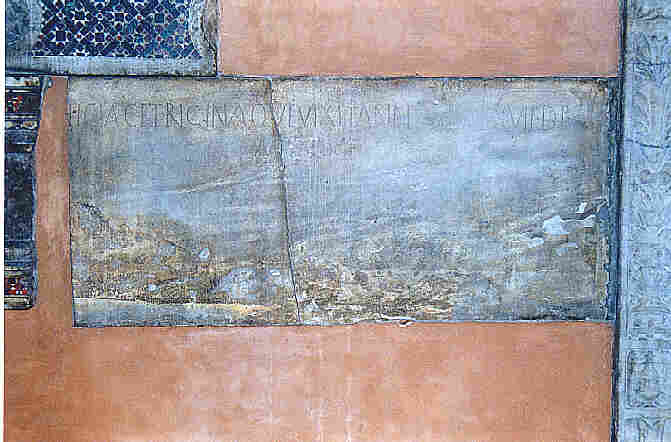
W2.
Text:
Hic iacet Rigina qu<a>e vixit
annus pl(us) m(inus) XVII d(e)p(osita)
XVII kal(endas) oct(obres)
Translation: ”Here lies Regina, who
lived more or less for seventeen years and
was buried seventeen days before the kalendae of October (the 15th of september).”
The narrow letter-proportions and
the thin lines without modulation are
typical for early christian inscriptions.
The crux monogrammatica in the
upper line and the formula hic
iacet date the inscription to the 4th or 5th
century. (ICUR I, 428; ILCV
3060; de Rossi 1872–73, 51) |
S5 (photo, see S7 below).
Text:
LUS Qui vixit
[l]EOnis de[p]
Translation: ”...lus who lived ...
buried [during the consulate of] Leo”
(late 5th century)
The letters are irregular with no
line-modulation and inconsistently used serifs.
X has the typical emphasis on the diagonals, which is common in
inscriptions of late antiquity. ”The
consulate of Leo” would date the inscription
to 458, 474 or 475. (ICUR I, 423; de Rossi 1872–73, 49) |
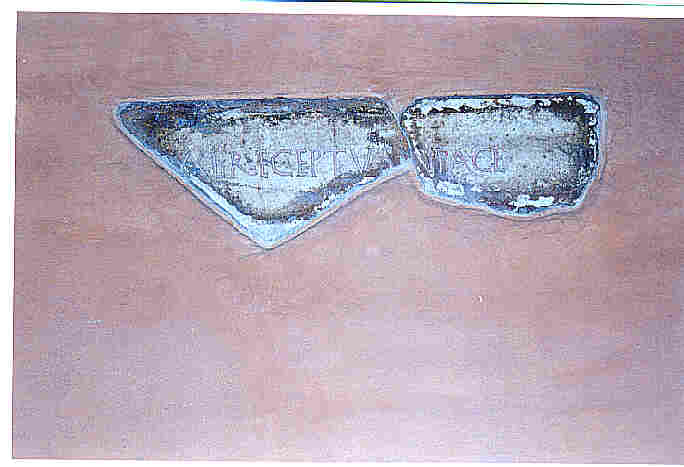
S6.
Text:
[---] nus XXII receptus in pace
[---] s
Translation: ”... twenty-two years,
received in peace ...”
The letter-proportions are close
to the Roman capitalis quadrata, and the formula receptus in
pace dates the inscription to the 3rd or 4th century. (ICUR
I, 429; ILCV
2922, de Rossi 1872–73, 49) |
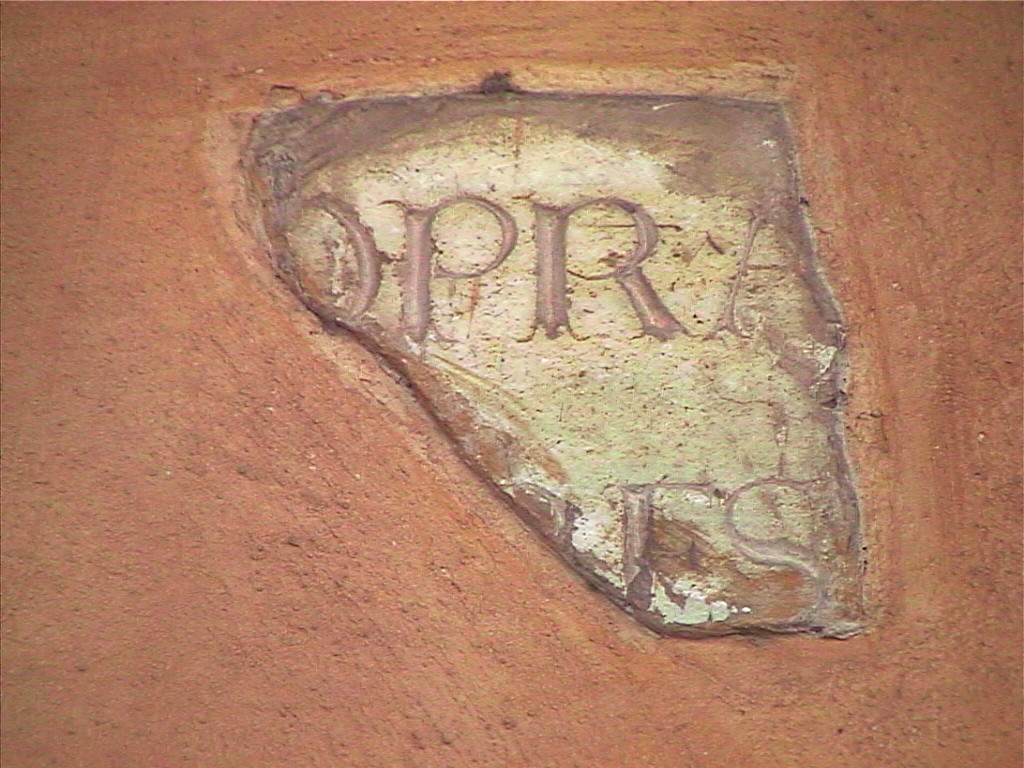
S7.
Text:
[---] opra [---] resb [---]
This fragment originates from an
inscription of pope Damasus (366–384). He was the author of several inscriptions
in verse about martyrs. The designer of the very beautiful letter-forms
was the pope's friend Furius Dionysius Filocalus. The
distinct character of the letters – a remarkable contrast between thick
and thin strokes, the stem ending in
a drop-shape, and thin, curled, elegant serifs – makes it possible to distinguish
the filocalian letter from imitations
and thus confirm the origin of an inscription even in a very
small fragment like this. (ICUR
I, 425; de Rossi 1872–73, 52; Ihm 1895, 54; ED 56) |
All the inscriptions above are preserved
in the portico.
The Paulus-inscription
parce praecor Paulo sanct[oru]m maxim[e
praesul]
alta patere poli fac illi culmina
Chr[iste]
vivat in aeterio felix per secla
[senatu]
luce fruatur ovans [re]gno laetetur
O[lympi]
vita sequatur eum mortis sic
vincula vincat
semper in aeterna caelesti floreat
aula
pauso sepultus ego Paulus praesentib(us)
exul
dep(ositus) id(ibus) mart(iis)
ind(ictione) VI temp(ore) d(omini) n(ostri)
Hadriani papae
”Have mercy upon Paulus, I beg, o
foremost of the hallowed;
Open the heights of the sky for
him, o Christ;
May he live fortunate through the
centuries in the ethereal senate;
May he enjoy the light, exultant,
and rejoice in the kingdom of the Olymp;
May life follow him, and so may
he conquer the chains of death;
May he always flower in the eternal
palace of heaven.
Here I, Paulus, lie buried, an exile
from the present.
Buried on the Idus (the 15th) of
March, in the 6th indiction, in the time of our
lord pope Hadrianus.”
The inscription is hexametrical,
and the letter-forms are well-executed for the
late 8th century. The acrostics (the first and last letters of each
line, read from top to bottom) read
Paulus Levita (deacon). The inscription is
fixed to the wall to the right of the entrance to the Scavi. (ICUR
I, XIV, 2; de Rossi 1872–73, 42) |
The 12th century inscriptions
Five inscriptions from the 12th century
are preserved in the church. They
all relate to the eventfulness of
this period, including restorations after
the Norman sack in 1084; consecrations
and reconsecrations of the church,
new altars and an extensive collection
of relics. Four of them are situated
in the portico, and the fifth is
found on the cathedra hidden by the 17th
century wooden panel behind the
altar.
(Silvagni 1943, XXII, 2–3; XXIII,
2,6; XXVI, 4)
S10 Inscription
S10 describes how Leo, bishop of Ostia, consecrates an altar in S. Lorenzo
in Lucina on January the 24th, 1112; and a list is added of relics
deposited in it. The cathedra inscription also mentions this consecration,
but adds that the grid-iron of St. Laurentius and two vessels
filled with his blood were taken out
from the old altar by pope Paschal II,
and that the relics were viewed
for several days by the Roman people before bishop Leo’s consecration on
January the 24th. A mysterious time-error occurs in the inscription, namely
the date of 27th of January for pope Paschal’s action, which of course
can’t have occured after the consecration of the new altar. |
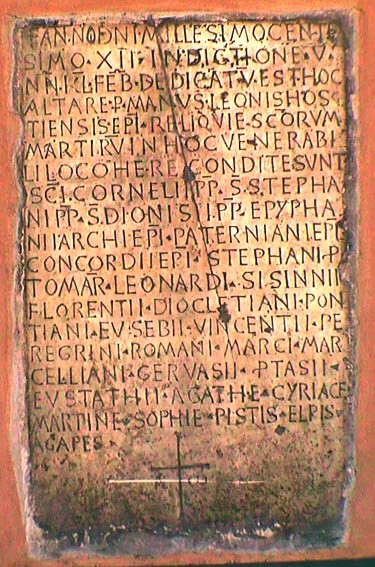 |
|
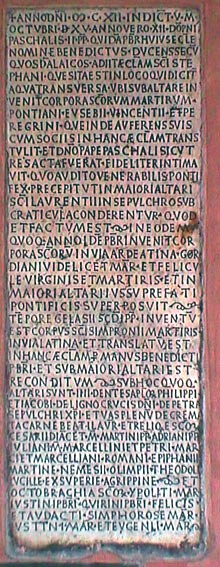 |
Inscription no. S4
tells about a certain presbyter called Benedictus,
collecting relics of martyrs to the
church between the years 1112–1119, and the relics are put in the high
altar under the grid-iron of St. Laurentius. Then follows a long list of
other relics deposited in this place, among them a vessel filled with burnt
flesh of St. Laurentius. |
|
| Inscription no. S9
describes the antipope Anacletus II consecrating the whole church in 1130,
perhaps when the restorations, started under pope Paschal II, were completed. |
 |
|
The Lateran council of 1139, however,
cancelled all actions performed by the antipope, and a new consecration
was needed. This was made as late as 1196 by pope Celestinus III, an event
which is recorded in inscription no. S3.
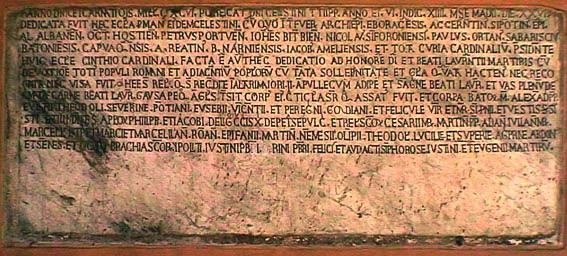
|
| Bibliography
Ihm 1895
Anthologiae Latinae Supplementa:
Damasi epigrammata, ed. M. Ihm, Leipzig 1895.
ED
Epigrammata Damasiana, ed.
Ferrua, A., Città del Vaticano 1942.
ICUR
Inscriptiones Christianae Urbis
Romae I, ed. Silvagni, Roma 1922.
ILCV
Inscriptiones Latinae Christianae
Veteres, ed. E. Diehl, Berlin 1961.
Silvagni 1943
Monumenta epigraphica Christiana
saeculo XIII antiquiora, ed. A. Silvagni, Città del Vaticano
1943.
de Rossi 1872–73
de Rossi, G. B., ”Sepolcri del secolo
ottavo scoperti presso la chiesa di S. Lorenzo in Lucina”, Bullettino
della commissione archeologia municipale, 1872–73, pp. 42–53. |
|






